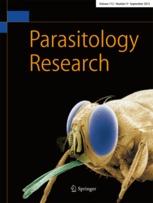Ver ítem
- xmlui.general.dspace_homeCentros Regionales y EEAsCentro Regional Patagonia NorteEEA BarilocheArtículos científicosxmlui.ArtifactBrowser.ItemViewer.trail
- Inicio
- Centros Regionales y EEAs
- Centro Regional Patagonia Norte
- EEA Bariloche
- Artículos científicos
- Ver ítem
Identification of Sarcocystis spp. in wild boars (Sus scrofa) from Argentina
Resumen
Sarcocystis spp. are intracellular protozoan parasites with an obligatory heteroxenous life cycle. The objective of this study is to identify Sarcocystis spp. in wild boar muscles from Argentina by light and transmission electron microscopy and molecular characterization. Muscle samples from diaphragm, tongue, masseter, intercostals, heart, and forelimbs of 240 wild boars were analyzed. Of the animals, 48.3% (116/240) were positive for sarcocysts by light
[ver mas...]
Sarcocystis spp. are intracellular protozoan parasites with an obligatory heteroxenous life cycle. The objective of this study is to identify Sarcocystis spp. in wild boar muscles from Argentina by light and transmission electron microscopy and molecular characterization. Muscle samples from diaphragm, tongue, masseter, intercostals, heart, and forelimbs of 240 wild boars were analyzed. Of the animals, 48.3% (116/240) were positive for sarcocysts by light microscopy, whereas 45.8% (110/240) were positive for Sarcocystis spp. by PCR targeting 18S rRNA fragment. These samples were subjected to a specific PCR for S. suihominis coxI gene, 3.6% (4/110) of which were weak positives. Unfortunately, sequence analysis was inconclusive. This could be related to a potentially low S. suihominis cyst load in the samples, or to an incomplete primer matching with the South American S. suihominis sequences. Seventeen individual sarcocysts were positive by PCR for the 18S rRNA fragment, whose sequences showed 99.75–100% identity with each other and with previously reported S.miescheriana sequences. A total of 21 cysts collected from 11 muscle samples and analyzed by TEM presented a cyst wall type compatible with S. miescheriana, and one cyst presented an ultrastructure compatible with S. suihominis. The latter came from a sample that also contained S. miescheriana cysts, indicating that the animal was co-infected. This is the first study that provides infection rates and describes and identifies morphological and molecular features of Sarcocystis spp. cysts in wild boars from South America.
[Cerrar]

Autor
Helman, Elisa;
Dellarupe, Andrea;
Cifuentes, Sabrina;
Chang Reissig, Elizabeth;
Moré, Gastón;
Fuente
Parasitology Research (Published: 06 December 2022)
Fecha
2022-12
Editorial
Springer
ISSN
0932-0113
1432-1955
1432-1955
Formato
pdf
Tipo de documento
artículo
Palabras Claves
Derechos de acceso
Restringido
 Excepto donde se diga explicitamente, este item se publica bajo la siguiente descripción: Creative Commons Attribution-NonCommercial-ShareAlike 2.5 Unported (CC BY-NC-SA 2.5)
Excepto donde se diga explicitamente, este item se publica bajo la siguiente descripción: Creative Commons Attribution-NonCommercial-ShareAlike 2.5 Unported (CC BY-NC-SA 2.5)

